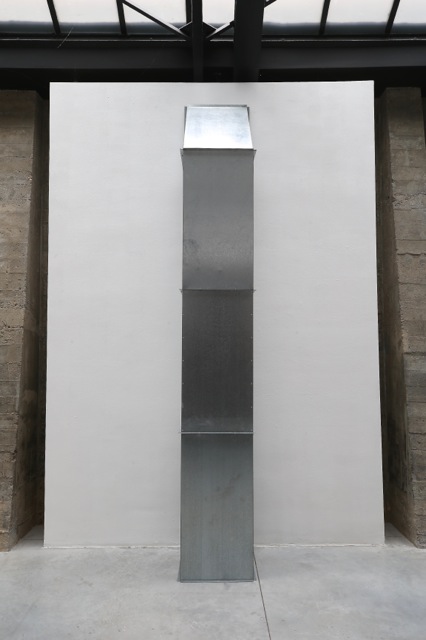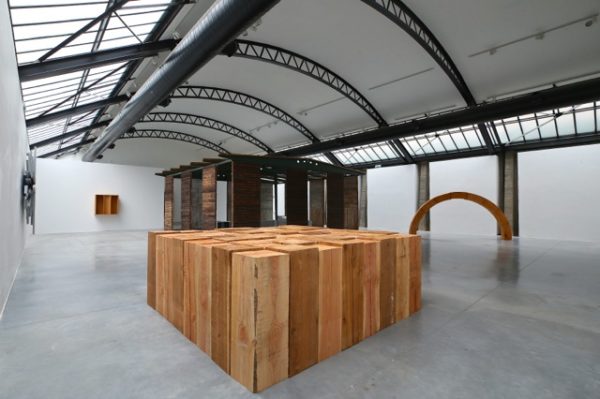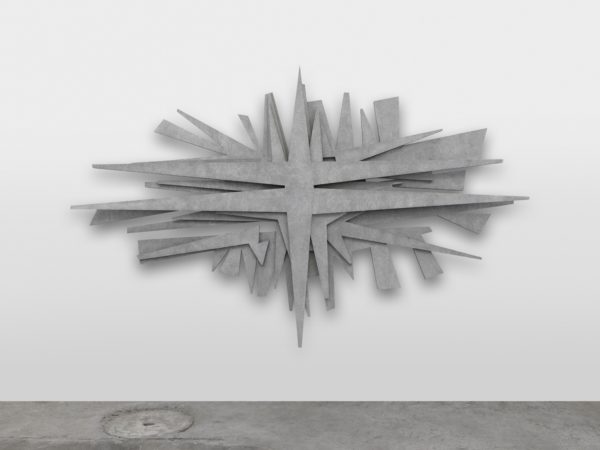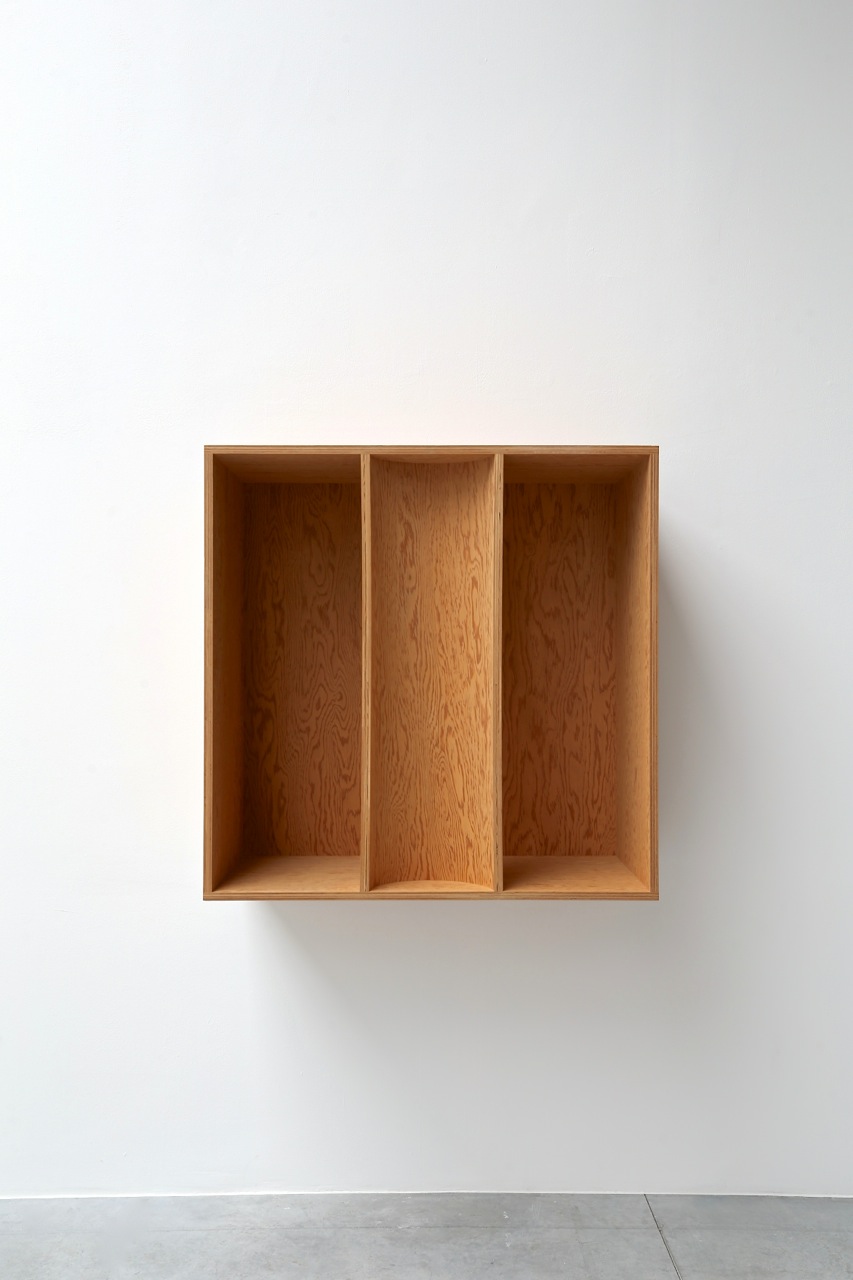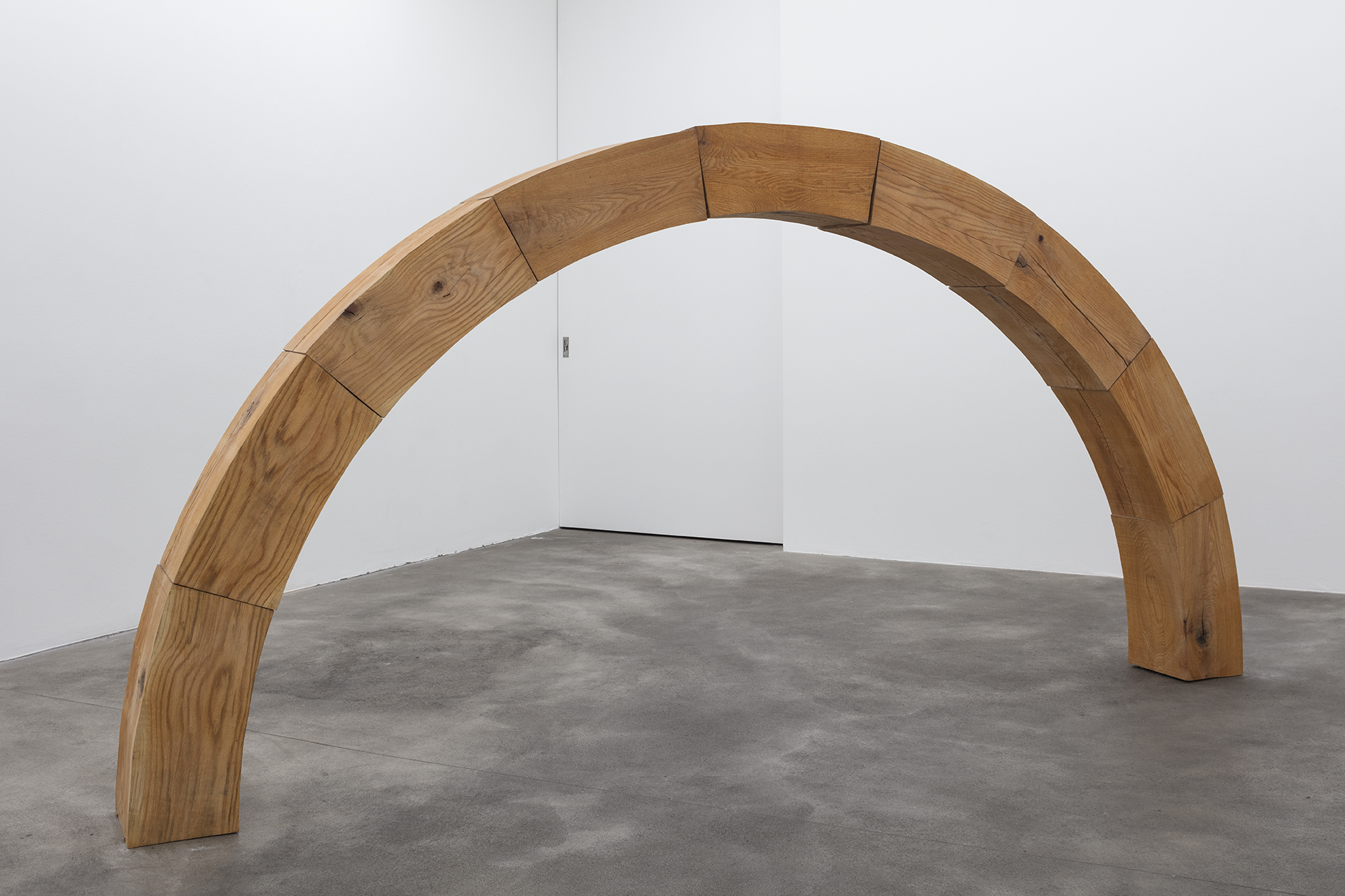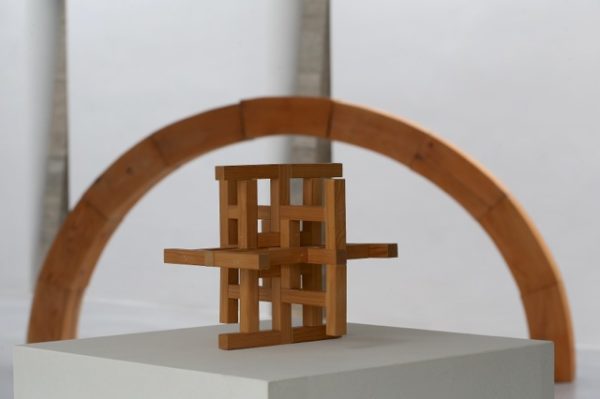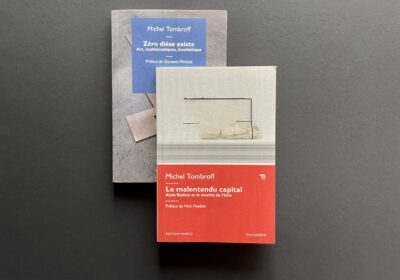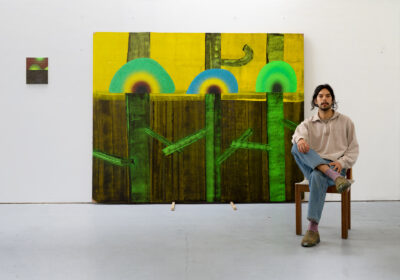Carl Andre, 8 x 8 Cedar Solid, 2011, 64 Western Red Cedar blocks, each 90 x 30 30 cm, 90 x 240 x 240 cm.
Courtesy the artist and Konrad Fischer Galerie
Carl Andre
Born in 1935 in the United States
Valentin Carron, Speed and Aluminum and Trembling, 2017, Composite panels, acrylic paint, 236,5 x 385 x 23,5 cm. Courtesy the artist.
Valentin Carron
Born in 1977 in Switzerland
Valentin Carron’s large-scale grey and star-shaped wall relief entitled Speed and Aluminum and Trembling(2017) blurs the boundaries between sculpture and post-war architectural ornament, modernism and postmodernism. Moreover, echoing Morris’ exception to the refusal to use paint, the metallic surface of this impressive sculpture is actually a trompe-l’oeil: the metal is in fact imitated and gives the viewer an impression of a hefty, physical presence.
Emilie Ding, Untitled, 2016, calcined felter, galvanised steel, 200 x 193 x 29 cm. Courtesy the artist and Galerie Samy Abraham.
Émilie Ding
Born in 1981 in Switzerland
Harking back to both concrete art and postminimalism, Emilie Ding’s large and thick felt works do not use paint: their surface is partially burnt with a blowtorch, creating a clear-cut geometric pattern. Rather than being presented on a stretcher (which would flatten and conceal their nature or character) they are hung directly on the wall or suspended with a simple metal bar, balancing their own weight.
Ramon Feller, V, 2013, concrete, steel, ropes, electric motor, variable dimension. Courtesy the artist.
Ramon Feller
Born in 1988 in Germany
Playing with time and tensegrity (as theorised by Buckminster Fuller) Ramon Feller’s work slowly self-destructs over the course of the exhibition by means of an integrated set of cables pulling at the object laying on the floor. The work succumbs to entropy and leaves only a mark on the floor, a trace of the installation’s initial state.
Karsten Födinger, Void, 2012, reinforcement steel, 410x 610 x 410 cm. Courtesy the artist.
Karsten Födinger
Born in 1978 in Germany
Karsten Födinger has contributed an invasive steel structure to the exhibition, which also relates strongly to the viewer’s body and personal space, leaving only a narrow passageway for visitors entering and exiting the building. While simultaneously circular and authoritarian, transparent yet barricading, creates a tangible tension between the architectural space and its own seemingly unfinished state. Will a thick layer of concrete come and complete the sculpture, rendering it a permanent obstruction?
Donald Ji-udd, Untitled, 91-7 Ballentine, 1991, Douglas fir plywood, 100 x 100 x 50 cm. Courtesy Galerie Greta Meert.
Donald Judd
Born in 1928 in the United States
Donald Judd substitutes, in his series Specific Objects, chromatic variations and brushstrokes with wall-mounted volumes that project and embrace their surrounding space with their orthogonal appearances. Even though their surfaces are aimed at reaching an utmost neutrality according to the artist, they are very diverse on a visual level. Indeed, if they are most often made of dyed glass or plexiglass, their reflections are constantly changing the monochromatic tonalities. Some of them consist purely of wooden planks, such as the one exhibited here, in which the natural patterns of the veins and knots reveal their raw materiality, while also reminding us of their negative imprint on concrete volumes.
Robert Morris, Roman Arch, 2014, oak, 152,4 x 365,8 x 30,5, cm. Courtesy Castelli Gallery and Sprüth Magers.
Robert Morris
Born in 1931 in the United States
Robert Morris, a pioneer of minimalist sculpture and process art,draws attention to the integral importance of the space around a sculpture as well as the viewer’s perception of the object itself. Constructed originally as a stage device for a performance in New York in 1961, Morris would stand inside the column operating a rope device to make the sculpture’s walls appear to fall outwards in a seemingly invisible action.
Charlotte Posenenske, Vierkantrohre. Serie D, reconstruction, steel sheds, variable dimensions. Courtesy Fondation CAB, collection Hubert Bonnet.
Charlotte Posenenske
Born in 1930 in Germany
This logic is carried on to the 1960s with Charlotte Posenenske’s Square Tubes series presented here inside Jean Prouvé’s Maison Démontable(1944), here deprived of roof and walls. The house is rendered purely as a structure, separated from its initial function of dwelling and shelter. In the same manner, Posenenske’s galvanised air ducts are stripped of their original capacity to contain and direct air: indeed, the only thing they channel here is the viewer’s gaze. The pipes can be combined to create any number of configurations, allowing the curator to modify the installation according to her or his own criteria, relinquishing some of the artist’s creative autonomy to others.
Alexandre Rodchenko, Spatial Construction No.20, 1920-1921-1993, wood, 27 x 27 x 27 cm. Courtesy Alexander Lavrantiev and Galerie Gmurzynska.
Alexander Rodchenko
Born in 1891 in Russia
Under their own denomination of “industrial art”, certain constructivist sculptors including Alexander Rodchenko favoured the exclusive use of materials taken directly from industrial production processes as opposed to marble or bronze (see, for example, his 1920s industrially cut Spatial Constructionsculptures). The constructivists thus questioned the inherent value of artworks which was too often measured by cost, preciousness or rarity of material components, or “style”. Their answer was to impose a purely technical approach to materials based on three principles: a) Architectonics (the creative act) b) Workmanship (how things are made), and c) Construction. In their eyes, an artwork was more than a cosa mentale: above all it was the fruit of a new way of thinking, a new configuration, and was necessarily analytical, abstract, and “constructed”. A far cry from any artisanal preciousness or craftsmanship skills, the sculptures in this exhibition do indeed construct the foundations for an alternative relationship between viewer and artwork.
Killian Rütermann, Untitled (Sarkophagus) 2010, Polyethurane foam
Killian Rüthemann
Born in 1979 in Switzerland
Killian Rüthemann’s foam sculpture Untitled (Sarcophagus)(2018) is placed outside to weather and deteriorate. It forms a block, carved with enough space for a human body to fit into it. Sitting like a sarcophagus awaiting its guest (addressing itself to visitors, perhaps), it resonates with Robert Morris’ own 1960s open sarcophagus (Untitled (Box for Standing), 1961), inside which he would stand during an on-stage performance.

